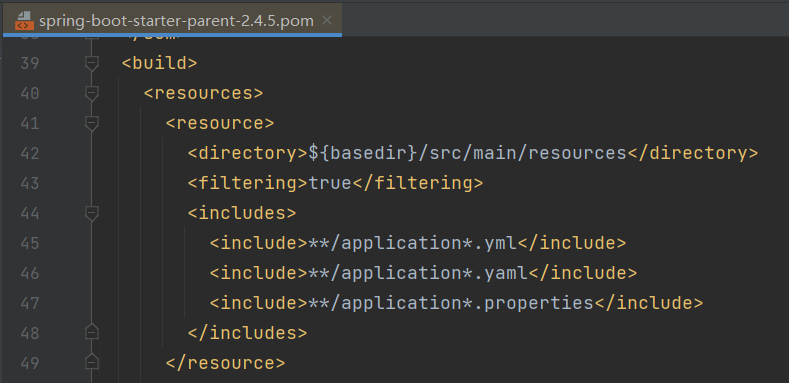SpringBoot
- SpringBoot是搭建spring应用的脚手架,基于【约定优于配置】的思想简化配置来进一步简化了Spring应用的整个搭建和开发过程
- 解决的问题:
- Spring复杂的配置
- 混乱的依赖管理
- 特点:
- 快速创建独立的Spring应用
- 提供固定的启动器依赖简化组件配置,通过自己设置配置文件,即可快速使用
- 只需要导入框架的启动器,该框架对应的依赖就会全部自动导入
- 提供了常见的非功能性特性,如内嵌Tomcat服务器(默认端口8080)、安全、指标、健康检测、外部化配置等
pom.xml配置文件
<?xml version="1.0" encoding="UTF-8"?>
<project xmlns="http://maven.apache.org/POM/4.0.0"
xmlns:xsi="http://www.w3.org/2001/XMLSchema-instance"
xsi:schemaLocation="http://maven.apache.org/POM/4.0.0 http://maven.apache.org/xsd/maven-4.0.0.xsd">
<modelVersion>4.0.0</modelVersion>
<groupId>com.itheima</groupId>
<artifactId>springboot_demo</artifactId>
<version>1.0-SNAPSHOT</version>
<!--1. 凡是springboot项目都必须要继承一个父模块,主要是对版本依赖进行统一管理-->
<parent>
<groupId>org.springframework.boot</groupId>
<artifactId>spring-boot-starter-parent</artifactId>
<version>2.3.12.RELEASE</version>
</parent>
<!-- 2. 需要使用哪个框架,那么就导入对应框架的启动器即可。
比如:springmvc - starter-web-->
<dependencies>
<dependency>
<groupId>org.springframework.boot</groupId>
<artifactId>spring-boot-starter-web</artifactId>
</dependency>
</dependencies>
</project>
启动类
启动类就是带
@SpringBootApplication注解的普通Java类,是运行SpringBoot项目的入口类核心代码
package com.itheima; import org.springframework.boot.SpringApplication; import org.springframework.boot.autoconfigure.SpringBootApplication; /** * 该类就是一个启动类,就是当前程序的入口,启动类要求如下: * 1. 类上必须@SpringBootApplication 注解 * 2. 必须在main里面使用SpringApplication.run(当前类的class,args),写法是固定的。 */ @SpringBootApplication public class DemoApplication { public static void main(String[] args) { SpringApplication.run(DemoApplication.class, args); } }【Tip】@SpringBootApplication注解的源码有一个@ComponentScan的注解,默认扫描启动类所在包以及它的子包
配置文件
- 在父模块中,默认定义了配置文件的命名规范和存放位置
- 默认存放位置(file: 指当前项目根目录;classpath: 指当前项目的类路径)
- file:./config/*/
- file:*/config/
- file:./
- classpath:./config/
- classpath:/
- 加载顺序(优先级低到高):yml ---> yaml ---> properties(存在相同的配置内容时,高优先级的内容会覆盖低优先级的内容)
- 默认存放位置(file: 指当前项目根目录;classpath: 指当前项目的类路径)
yml配置文件
server: servlet: context-path: / port: 8080 my: host: localhost port: 1234 user: id: 100 name: 张三 age: 23 # 定义数组时,每个元素必须是”-空格“开头 address: - 北京 - 上海 - 深圳 userList: - id: 101 name: 李四 age: 24 - id: 102 name: 王五 age: 25
读取配置文件
- 方式一:@Value
- 缺点:只能读取简单类型数据(基本类型+String)
- 方式二:@ConfigurationProperties
- 属性名必须与配置文件key一致
- 所有需要注入的属性,都必须提供setter方法
- 缺点:复用性差
package com.itheima.controller;
import com.itheima.domain.User;
import lombok.Data;
import org.springframework.beans.factory.annotation.Value;
import org.springframework.boot.context.properties.ConfigurationProperties;
import org.springframework.web.bind.annotation.GetMapping;
import org.springframework.web.bind.annotation.RestController;
@RestController
@Data
@ConfigurationProperties(prefix = "my")
public class PropController {
//@Value("${my.port}")
private Integer port;
// @Value("${my.host}")
private String host;
private User user;
@GetMapping("/prop1")
public String prop1(){
System.out.println("读取到的内容:port:"+port+" host:"+host);
return "success";
}
@GetMapping("/prop2")
public String prop2(){
System.out.println("读取到的内容:port:"+port+" host:"+host+" user对象:"+ user);
return "success";
}
}
方式三:@ConfigurationProperties + @EnableConfigurationProperties
@ConfigurationProperties: 配置属性@EnableConfigurationProperties(配置类.class): 启用配置属性使用时需要注入的属性封装成一个属性类,当用到的时候 需要 启用配置属性
定义属性类
package com.itheima.config; import com.itheima.domain.User; import lombok.Data; import org.springframework.boot.context.properties.ConfigurationProperties; import org.springframework.stereotype.Component; import java.util.List; @Data @ConfigurationProperties(prefix = "my") //@Component不建议在SpringBoot中使用 public class PropConfig { private Integer port; private String host; private User user; private String[] address; private List<User> userList; }启用配置属性
```java package com.itheima.controller;
import com.itheima.config.PropConfig; import com.itheima.domain.User; import lombok.Data; import org.springframework.beans.factory.annotation.Autowired; import org.springframework.beans.factory.annotation.Value; import org.springframework.boot.context.properties.ConfigurationProperties; import org.springframework.boot.context.properties.EnableConfigurationProperties; import org.springframework.web.bind.annotation.GetMapping; import org.springframework.web.bind.annotation.RestController;
import java.util.Arrays;
@RestController @EnableConfigurationProperties(PropConfig.class) //在springboot里面创建属性配置类的对象一般别人没有使用@Compnent注解,一般都习惯使用@EnableConfigurationProperties(PropConfig.class) public class PropController {
@Autowired private PropConfig propConfig;
@GetMapping("/prop1")
public String prop1(){
System.out.println("读取到的内容:port:"+propConfig.getPort()+" host:"+propConfig.getHost());
return "success";
}
@GetMapping("/prop2")
public String prop2(){
System.out.println("读取到的内容:port:"+propConfig.getPort()+" host:"+propConfig.getHost()+" user对象:"+ propConfig.getUser());
return "success";
}
@GetMapping("/prop3")
public String prop3(){
System.out.println("读取到的内容:port:"+propConfig.getPort()+" host:"+propConfig.getHost()+" user对象:"+ propConfig.getUser());
System.out.println("住房地址:"+ Arrays.toString(propConfig.getAddress()));
System.out.println("用户对象:"+ propConfig.getUserList());
return "success";
}
}
### 整合lombok
- 第一步:在IDEA中安装lombok插件
- 第二步:导入lombok依赖
```xml
<!-- 引入lombok -->
<dependency>
<groupId>org.projectlombok</groupId>
<artifactId>lombok</artifactId>
</dependency>
第三步:使用注解
@Data自动生成getter、setter、hashCode、equals、toString方法@AllArgsConstructor自动生成全参构建器@NoArgsConstructor自动生成无参构建器@Slf4j自动在bean中提供log变量,其实用的是slf4j的日志功能@Setter自动生成setter方法@Getter自动生成getter方法@EqualsAndHashCode自动生成equals、hashCode方法@ToString自动生成toString方法@NonNull这个注解可以用在成员方法或者构造方法的参数前面,会自动产生一个关于此参数的非空检查,如果参数为空,则抛出一个空指针异常
import lombok.extern.slf4j.Slf4j; import org.springframework.web.bind.annotation.GetMapping; import org.springframework.web.bind.annotation.RestController; @RestController @Slf4j //一旦使用@Slf4j这个注解,我们就可以直接使用一个log变量输出日志信息 public class LogController { /* info warn(警告) , error(错误级别) */ @GetMapping("/log") public String log(){ log.info("======log的普通日志信息======="); log.warn("======log的警告日志信息======="); log.error("======log的错误日志信息======="); //System.out.println("========sout的信息========="); //sout语句以后不准出现在正常业务代码里面(效率非常低) return "log success"; } }
整合SpringMVC
- 默认的静态资源访问路径
- classpath:/META-INF/resources/
- classpath:/resources/
- classpath:/static/
- classpath:/public/
添加拦截器
如果你想要保持Spring Boot 的一些默认MVC特征,同时又想自定义一些MVC配置(包括:拦截器、格式化器、视图控制器、消息转换器 等等),你应该让一个类实现
WebMvcConfigurer,并且添加@Configuration注解,但是千万不要加@EnableWebMvc注解。如果你想要自定义HandlerMapping、HandlerAdapter、ExceptionResolver等组件,你可以创建一个WebMvcRegistrationsAdapter实例 来提供以上组件。如果你想要完全自定义SpringMVC,不保留SpringBoot提供的一切特征,你可以自己定义类并且添加
@Configuration注解和@EnableWebMvc注解
实现步骤
第一步:自定义拦截器实现HandlerInterceptor接口
package com.itheima.interceptor; import lombok.extern.slf4j.Slf4j; import org.springframework.stereotype.Component; import org.springframework.web.servlet.HandlerInterceptor; import org.springframework.web.servlet.ModelAndView; import javax.servlet.http.HttpServletRequest; import javax.servlet.http.HttpServletResponse; /* 拦截器的编写步骤: 1. 自定义一个类实现HandlerInterceptor */ @Slf4j @Component public class Demo1Interceptor implements HandlerInterceptor { @Override public boolean preHandle(HttpServletRequest request, HttpServletResponse response, Object handler) throws Exception { log.info("【前置通知】"); return true; } @Override public void postHandle(HttpServletRequest request, HttpServletResponse response, Object handler, ModelAndView modelAndView) throws Exception { log.info("【后置通知】"); } @Override public void afterCompletion(HttpServletRequest request, HttpServletResponse response, Object handler, Exception ex) throws Exception { log.info("【最终通知】"); } }
第二步:自定义配置类实现WebMvcConfigurer接口,注册拦截器
package com.itheima.config; import com.itheima.interceptor.Demo1Interceptor; import org.springframework.beans.factory.annotation.Autowired; import org.springframework.context.annotation.Configuration; import org.springframework.web.servlet.config.annotation.InterceptorRegistry; import org.springframework.web.servlet.config.annotation.WebMvcConfigurer; @Configuration public class SpringMvcConfig implements WebMvcConfigurer { @Autowired private Demo1Interceptor demo1Interceptor; @Override public void addInterceptors(InterceptorRegistry registry) { registry.addInterceptor(demo1Interceptor).addPathPatterns("/log"); } }
整合Mybatis
第一步:导入Mybatis启动器依赖(它依赖了jdbc启动器,jdbc启动器可以删除)
<!--myabtis--> <dependency> <groupId>org.mybatis.spring.boot</groupId> <artifactId>mybatis-spring-boot-starter</artifactId> <version>2.1.0</version> </dependency>第二步:在application.yml中进行相关配置
spring: datasource: driver-class-name: com.mysql.jdbc.Driver url: jdbc:mysql:///springdb?useSSL=false username: root password: root mybatis: #别名扫描,别名扫描实体类的包作用就是可以直接类名在resultType里面 type-aliases-package: com.itheima.domain configuration: #开启下划线与小驼峰映射 map-underscore-to-camel-case: true #开启sql日志记录 log-impl: org.apache.ibatis.logging.stdout.StdOutImpl #指定mapper文件所在的目录,一旦指定之后,那么xml文件可以与接口不在同一个包下了,如果不指定是需要在同一个目录下 mapper-locations: - classpath:mapper/*.xml #这里代表的是一个数组的元素,是一个整体,不需要有空格
数据访问接口注解
方式一:在接口类上使用@Mapper注解
@Mapper public interface UserDao { public List<User> findAll(); }方式二:在启动类上添加数据访问接口包扫描
package com.itheima; import org.mybatis.spring.annotation.MapperScan; import org.springframework.boot.SpringApplication; import org.springframework.boot.autoconfigure.SpringBootApplication; /** * 注意: 使用mybatis的时候,这个springboot默认是不扫描dao接口的,两种解决方案: * 1. 每一个dao接口都添加一个@mapper注解,不推荐,因为较为繁琐 * 2. 在启动类中@MapperScan注解扫描dao包 */ @SpringBootApplication @MapperScan(basePackages = "com.itheima.dao") public class DemoApplication { public static void main(String[] args) { SpringApplication.run(DemoApplication.class, args); } }
整合Junit
导入test启动器依赖
<!-- 配置test启动器(自动整合spring-test、junit) --> <dependency> <groupId>org.springframework.boot</groupId> <artifactId>spring-boot-starter-test</artifactId> <scope>test</scope> </dependency>编写测试类
package com.itheima.test; import com.itheima.MybatisApplication; import com.itheima.entity.User; import com.itheima.service.UserService; import org.junit.jupiter.api.Test; import org.springframework.beans.factory.annotation.Autowired; import org.springframework.boot.test.context.SpringBootTest; import java.util.List; /* 注意的事项: 1. 测试类如果与启动类在同一个包或者是子包,那么测试类可以不指定启动类的位置。 2. 测试类不在启动类在同一个包或者是子包,测试类必须指明启动类的位置 */ //@SpringBootTest(classes = MybatisApplication.class) //不在子包下则需要指定启动类的位置 @SpringBootTest public class AppTest { @Autowired private UserService userService; @Test public void testFindAll(){ List<User> userList = userService.findAll(); System.out.println("用户列表:"+userList); } }
项目打包部署
第一步:导入打包插件
<!--打包的插件--> <build> <!--修改jar的名字--> <!--可省略 <finalName>ROOT</finalName> --> <plugins> <plugin> <groupId>org.springframework.boot</groupId> <artifactId>spring-boot-maven-plugin</artifactId> </plugin> </plugins> </build>第二步:执行打包命令(需要配置maven系统变量,然后在项目路径下使用该命令)
# 清理、打包 跳过测试 mvn clean package -Dmaven.test.skip=true第三步:运行打包好的jar包
java -jar xxx.jar
多环境动态切换(profile配置)
我们在开发Spring Boot应用时,通常同一套程序会被安装到不同环境,比如:开发、测试、生产等。其中数据库地址、服务器端口等等配置都不同,如果每次打包时,都要修改配置文件,那么非常麻烦。profile功能就是来进行动态配置切换的。
多文件方式
- profile文件设置(提供多个配置文件,每种文件代表一种环境)
- application-dev.properties/yml:开发环境
- application-test.properties/yml:测试环境
- application-pro.properties/yml:生产环境
- 激活方式:在application.properties配置文件中配置:
spring.profiles.active=dev
yml单文件方式
在application.yml配置文件中写上三种环境的配置信息并激活
--- server: port: 8082 spring: profiles: dev --- server: port: 8083 spring: profiles: test --- server: port: 8084 spring: profiles: pro --- # 激活配置 spring: profiles: active: test


